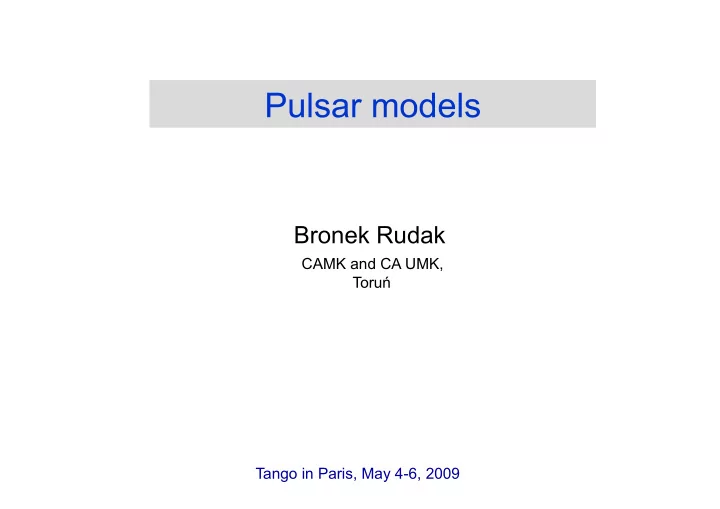

Bronek Rudak CAMK and CA UMK, Toru ń Tango in Paris, May 4-6, 2009
In the talk: - Models of pulsars as sources of high energy photons. - Why the composition of pulsar winds (e ± content in the context of CR positrons) is connected to the pulsed emission properties? - Are the results from Fermi LAT challenging to the models?
Individual nearby pulsars Millisecond pulsars - Buesching et al., 2008 Reacceleration and evolution of Middle-age pulsars - Buesching et al.2008, magnetospheric pairs when trapped Malyshev et al. 2009, in PWNe. Semi-empirical treatment used to obtain the input for subsequent propagation. Galactic population Chi et al. 1996, Pulsars are treated just as time Malyshev et al. 2009, -dependent energy suppliers Barger et al. 2009 at the rate of ~L sd (t). This list is not complete.
Galactic population of pulsars Barger et al.2009 Assumed pair injection spectrum and spatial distribution of pulsars + propagation using GALPROP
1) Rotating, strongly magnetized neutron stars -> unipolar inductors 2) Maximum potential drop (for vacuum rotator) V max ≈ 6 × 10 12 B 12 P -2 Volts, i.e. for young pulsars V max can exceed 10 16 Volts Actual potential drops are much smaller, but high enough to accelerate charged particles to ultrarelativistic energies emitting in turn high energy photons.
1667 pulsars ATNF Pulsar Database F. Giordano, 44th Rec. de Moriond: 13 radio-quiet psrs
Harding, Stern, Dyks, Frackowiak 2008 Daugherty & Harding 1982 The pairs spectrum: broken power-law γ min =10 2 , γ break = 5 × 10 3 , γ max = 2 × 10 5 δ 1 = 2.0, δ 2 = 2.8
Rudak & Dyks 99 P = 0.003 s L sd = 10 35 erg/s P = 0.056 s L sd = 10 36 erg/s
Dyks 1998 Lines of constant values . of N(e ± )/d 2 Simple criterium to choose promising nearby pulsars (in addition to the pulsar age)
Spectra and lightcurves as a result of - specific radiative processes, - location and spatial extent of the emitters, - geometry (i.e. inclination and viewing angles)
Fig. by K. Hirotani Variety of sizes and shapes of the accelerating gaps lead to a variety of energy spectra and anisotropies of emission. ‘Observed’ characteristics depend strongly on inclination angle and line of sight w.r.t. the spin axis.
Figs. by K. Hirotani Extended Polar Gap Slot Gap Tsygan & Muslimov Muslimov & Harding 2004 ∇ • E = 4 π ( ρ - ρ corot )
Full electrostatic potential drop Gap width: Δ V (SG) ∼ 10 13 V h SG ≅ 0.04 h OG ≅ 0.14 Δ V (OG) ∼ 10 15 V Outer Gaps more powerful than Slot Gaps in terms of gamma-ray luminosity
Similar Multiplicities: M e ± ~ 10 4 - 10 5 The rate of e ± -pairs in the wind: M e ± d N GJ / dt ≈ 3 × 10 38 s -1 ~ 100 times smaller than required for the Crab nebula
3D Slot Gap Model for the Crab Pulsar Harding, Stern, Dyks & Frackowiak 2008 CR + SR (primaries) + SR (pairs) + ICS (primaries with radio) α = 45 deg ζ = 100 deg MAGIC ×
The Crab Pulsar and 3D Outer Gap Model Hirotani, 2008 Synchro-curvature + ICS (pairs with IR) Intrinsic: black line Escaping: red line α = 60 deg ζ = 113 deg MAGIC
Dyks & Rudak 2003 Two-pole caustic model and outer gap model The Vela pulsar lightcurve (Kanbach 1998) Vela
Dyks et al. 2005 Outward emission along last open field lines Inward emission along last open field lines
2D Outer gap model of Vela w. significant inward emission Takata et al. 2008 Expected
Two groups with distinct properties in X-rays: 1) luminosity: relatively low, spectrum: mostly thermal-like lightcurve: broad single pulse best known: J0437-4715 2) luminosity: relatively high, spectrum: non-thermal, lightcurve: two narrow peaks best known: B1821-24, J0218+4232 Are these properties reflected in gamma rays?
3D Model of J0437-4715 : SCLF, unscreened E || Frackowiak & Rudak 2005 Photon maps and lightcurves above 100 MeV α = 35 ° , ζ = 40 ° α = 20 ° , ζ = 16 °
Surprising result ! Speaks for Outer Gaps?
3D model of B1821-24: SCLF, unscreened E || Frackowiak & R 2005 P = 3.1 ms, B = 0.002 TG α = 50 o d = 5.1 kpc bold line: for viewing angle ζ = 45 o photon flux above 100 GeV
Which models are appropriate for MPSRs ? J0218+4232, B1821-24 (but not in gamma-rays so far), J00307+0451: „mini-Crabs” (highly nonthermal MSPs): - slot gap or outer gap activity J0437-4715: - outer gap activity (??), any room for polar caps?
Rotation leads to non-axisymmetric magnetic absorption Dyks & Rudak02
Where to look for them? The Vela pulsar, Abdo et al. 2008 In gamma-ray lightcurves with double-peak structure. High photon-statistics close to cutoff energy is required. Asymmetric magnetic absorption: 1) Leading Peak becomes weaker than Trailing Peak close to cutoff energy 2) LP-TP separation changes dramatically at cutoff energy
Numerical example: Vela-like Model (Dyks & Rudak 02)
Slide by G. Kanbach
Recommend
More recommend